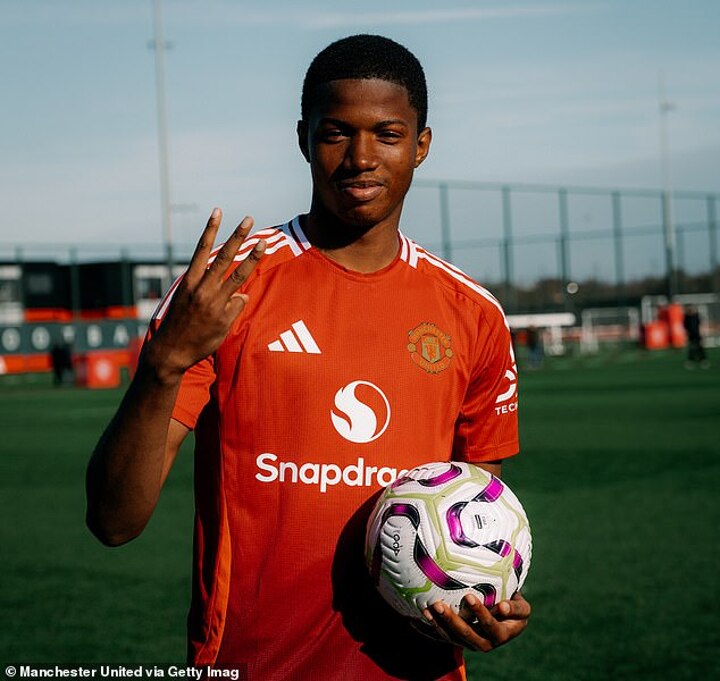It's not quite the same beautiful simplicity as Paul Scholes being persuaded to leave Oldham Athletic's youth squad for Manchester United, or Ryan Giggs' potential being spotted by an Old Trafford steward while playing for Salford Boys.
But a 16-year-old Danish striker wearing '9', or sometimes '16' in United's under-18s team has been emblematic of the club's decision to slow the recruitment of young players in the past month revised.
Chido Obi-Martin started scoring within five seconds of his first start for the side, against Nottingham Forest on a Saturday morning three weeks ago, and completed a hat-trick inside 14 minutes, in a 6-0 win.
He frowned when one of his team-mates received a ball he had aimed at the net during an 8-0 win over Leeds United at their Thorp Arch training base. He felt this should have been his goal.
Obi-Martin has an ego and is entitled to it, as he was one of the most talked about young players in youth football when United signed him from Arsenal's academy in July. He has speed and a surprisingly good touch for a player of 1.80 meters tall.
It wasn't just a case of United being able to offer Martin more money than Arsenal did this summer. United also convinced him that he would have a better chance of making the first team.
One of the unintended consequences of the fact that United's squad isn't exactly packed with world-beaters is that there is a more direct route to Premier League football than at Arsenal, where Mikel Arteta has been less willing to gamble on youth .
Obi-Martin, who scored 32 goals in 18 appearances for Arsenal under-18s and ten in one under-16 match against Liverpool, will have his sights set on Marcus Rashford's shirt if he continues his current trajectory. Despite all the problems of the Ten Hag years, 20-year-old Alejandro Garnacho, 19-year-old Kobbie Mainoo and 22-year-old Amad Diallo all prove that there is a path.
But United are belatedly embracing youth in a much bigger way than that. The club is behind Chelsea and Manchester City when it comes to purchasing young players as a way to generate profit if they are not up to the level and moving on.
City's academy made £205m from player sales in the four years from 2019, Chelsea made £307m in the same period and United just £90m. These figures put them 26th in a ranking of clubs ranked by revenue from player sales compiled earlier this year by the CIES Football Observatory.
Plans are in the pipeline to create a new structure that will see more young players signed than in the past, more loaned out to aid their development and more sold, to generate a profit valuable to United's compliance of the rules for financial sustainability.
Loans, crucial to the development of these players, have come under the auspices of Les Parry, the respected football man who was originally brought into the club by Sir Alex Ferguson, after a managerial career at Tranmere and Accrington, as a mentor to the kids who made the club . transition from youth to senior football. Parry came up with an honest truth about what they needed to do to make that leap. Ferguson saw value in the candor of Parry's approach and the respect it earned him.
Parry left United at the end of last month in the latest round of redundancies and Mick Cox, the academy manager, will take on his role for the time being, but the new structure could bring in new staff to take charge. A possible leader of the new structure could be Michael Appleton, who was in United's youth system between 1994 and 1997 before having a modest playing career and success as a manager.
Appleton sat next to Dan Ashworth, the club's sporting director, during the recent Under-21 Europa League match with Hertha Berlin. Perhaps a signal that he could lead the new structure in the new year, when Ineos is thought to have approved its financing.
Expenditure will be needed to set up that department and buy the players who will either be developed for the club or move on to make a profit for United. Players who have already started making money for the young Spaniard Alvaro Fernandez, picked up in the Spanish system, loaned to Preston and sold to Benfica.
Another is Hannibal Mejbri, now at Burnley after loan spells at Birmingham City and Sevilla.
United have recently selected some of the most promising youth players from the academy. Among them is Cardiff City's Gabriele Biancheri, who was brought in by Sir Alex to help sell the club's assets and seal the signing.
Crystal Palace boys Samuel Lusale and James Overy have arrived, as has left back Harry Amass, who joined from Watford 18 months ago. Sekou Kone is an 18-year-old Senegalese, bought from a Malian club.
The next player at the club could be 17-year-old Geovany Quenda, the Sporting Lisbon winger that many clubs are currently eyeing.
There are pitfalls to this strategy. Clubs' clamor for unproven youth academy players is driving up the wages of these boys to unhealthy levels. And more players around could complicate the route to the first team, with more pressure on the under-18 and under-21 spots.
But Obi-Martin is not thinking of being sold anywhere. United have gradually bloodied him and have not given him a full 90 minutes for the under-18s so far this season, but Denmark under-18 manager Morten Esksen did give him a first full game for the national team last week team against Finland. “That's his next step,” Esksen said. Denmark lost 2-1 to Finland, but Obi-Martin played and scored.
